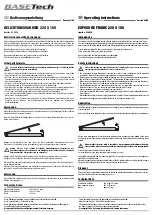
❯
Plug the connecting plug of the power supply
unit into the connection socket of the unit.
❯
Plug the mains plug into the power outlet.
❯
Replace the cover.
The cover on the rear must be properly
intalled when the device is operated
within the patient environment.
7.3
Connecting the unit to the
network
Purpose of the network connection
The network connection is used to exchange
information or control signals between the unit
and a software installed on a computer, in order
to, e. g.:
– Display parameters
– Select operating modes
– Indicate messages and error situations
– Change device settings
– Activate test functions
– Transmit data for archiving
– Provide documents concerning the devices
The unit can be connected to the network with a
network cable.
Combining devices safely
– Safety and essential performance features are
independent of the network.
– Faulty manual configuration can lead to signifi-
cant network problems. The expert knowledge
of a network administrator is required for con-
figuration.
– If, e. g., the following changes are made to the
network, new risks can arise that require fur-
ther analysis:
– Changes in the IT network configuration
– Connecting additional elements to the IT
network
– Removing elements from the IT network
– "Update" of devices that are connected to
the IT network
– "Upgrade" of devices that are connected to
the IT network
– The data connection utilizes part of the band-
width of the network. Interactions with other
medical devices cannot be completely
excluded. Apply the IEC 80001
‑
1 standard for
risk assessment.
– The device is not suitable to be connected
directly to the public internet.
Take care when connecting units together or to
parts of other systems as there is always an ele-
ment of risk (e.g. due to leakage currents).
❯
Only connect units when there can be no
question of danger to operator or to patient.
❯
Only connect units when it is safe to do so and
when there is no risk of damage or harm to the
surroundings.
❯
If it is not completely clear from the data sheet
of the unit that such connections can be safely
made or if you are in any doubt, always get a
suitably qualified person (e.g. the relevant man-
ufacturer) to verify that the setup is safe.
❯
Comply with the specifications of IEC 60601
‑
1
(EN 60601
‑
1) when connecting the appliance
with other appliances, e.g. a PC system, both
in and outside the patient environment.
❯
Only connect peripheral units (e.g. monitors,
printers) that meet at least the requirements set
out in IEC 60950
‑
1 (EN 60950
‑
1).
❯
The connected computer must conform to
EN 55032 (class B) and EN 55024.
Connecting the unit via the network cable
❯
Remove the cover from the rear of the device.
Installation
2160100287L41 1911V006
23
EN-
US
















































